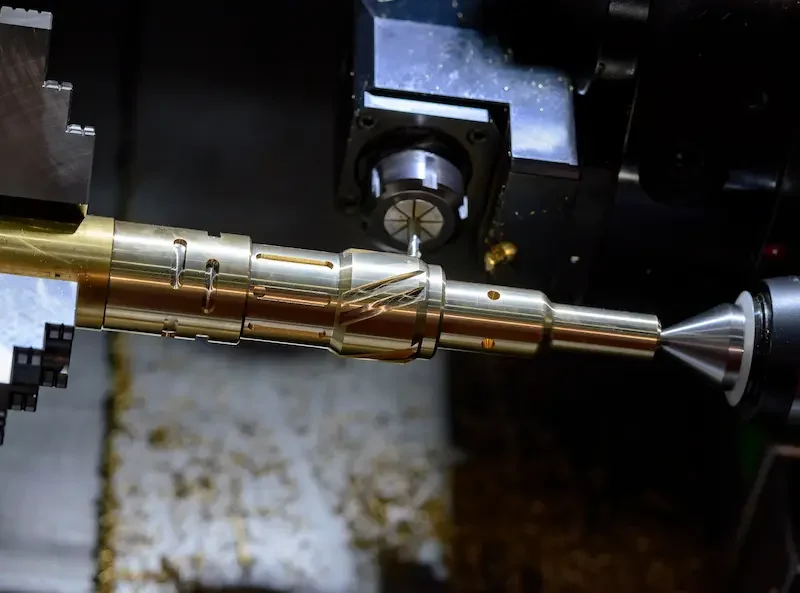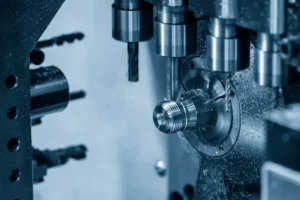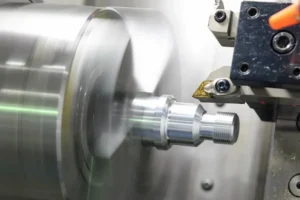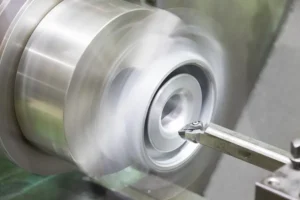
Turning machines are some of the most used pieces of equipment in industry and manufacture. This is large because they can perform turning and lathing operations, which constitute a staple manufacturing process. Throughout the years, turning machines and lathes have seen an incredible technological development, notably with the advent of CNC capabilities. Most machining centers and manufacturers use lathes and turning machines for different workpiece materials, and rely on CNC lathing and turning capabilities to save time and produce the most accurate parts and components.
Turning machines and lathes can come in many varieties, depending on the type of material or machining process they are designed to perform. Turning and lathing processes generally rely on high-speed rotations of the workpiece and a cutting tool to carve up the final shape. These processes have also developed with the advent of new techniques to this method. Notably, with CNC capabilities, the entire process can now be automated, and seldom requires the supervision of an operator. There are specific types of industrial pieces and components that are the specialty of turning and lathing processes. With today’s technological advances, these machines will likely be enabled to produce more complex shapes, in less time, as well as other machining processes.
Table of Contents
Definition
A turning machine is a type of industrial and manufacturing appliance, used mainly to produce parts and components with circular geometries. A turning machine can operate with a wide range of materials, including brittle materials like plastic, wood, some more solid materials like glass, some types of stone, and most metals. Turning machines can be used for metalworking processes, woodturning as well as other related processes. When working with metals, this process can often rely on a specific type of turning machine designed specifically for use with metals, known as a metal lathe.
The working process of most turning machines is more or less the same. The basic principle relies on high-speed rotations of the workpiece, which is attached to the clutch, and a cutting tool equipped to make cuts along the workpiece’s external surface. The cutting tool makes cuts along several axes to remove material from the outer surface until the desired shape and size and achieved. Although the turning principle is the same, turning machines and lathes can come in many varieties, depending on the material, speed, and feed, as well as capabilities in terms of different turning operations.
Types of Turning Machines
There are various types of turning machines, each differing in terms of workpiece material, specific turning operations that are compatible, as well as other technical features relating to the speed and feed of the machine and orientation of the single point cutting tool. Turning machines and lathes are often used interchangeably to refer to this sort of machinery. Although they can perform similar operations, they do differ in some aspects and capabilities.
Metal turning machines have long been distinctive compared to turning machines operating on other materials. However, most turning centers today, especially with CNC capabilities, rely on customized turning configurations that would allow them to work on most materials. The most important variable in differentiating turning machines is the operational capability. Some turning machines are only equipped to perform turning specific operations like facing, parting, and grooving, whereas others can also perform non-specific turning operations and boring.
CNC turning machines and lathes also offer a wide variety of equipment. We can mainly distinguish between vertical CNC turning machines and horizontal ones. The main difference between these two configurations is the axis orientation. With the recent advances in industry and technology, it is more common to find CNC turning centers with varied configurations compatible with many complex geometries and shapes.
Difference Betwen Turning Machine and Lathe

In most turning and lathing processes, turning machines and lathes, notably with CNC capabilities, can perform similar operations with almost the same level of accuracy and time-efficiency. Both processes rely on workpiece rotation and a single point cutting tool for the material removal process, and create mainly circular, as well as other, geometries. The CNC capability allows several aspects of both machines to be automated. However, CNC turning machines are generally more powerful as they can automate other operations like tool changing, enhanced chip removal, and other features.
Larger workpieces and heavy components are mostly produced using CNC turning machines instead of lathes. This is because lathes with CNC capabilities still require a skilled operator to overview the process. In most industrial uses, CNC lathes can be rotated sideways to machine large parts, all the while allowing operator access, which is less convenient this way. This is one of the main reasons why CNC turning machines are considered superior for heavy industrial use. Also, modern CNC turning machines can operate on more axes, which facilitates the creation of complex geometric figures, compared to lathes.
Turning Machine Processes

Turning machines are mostly associated with turning and lathing processes. These terms refer to separate groups of industrial processes used to produce circular geometries, which have developed to produce more. Modern turning machines with CNC capabilities are now equipped to perform all turning and lathing operations. These are processes specialized in cutting material from outer and inner surfaces. Although there is a distinction between the two groups of processes, modern machining centers are equipped to perform most of these operations through different configurations.
Turning generally refers to operations applied to the outer surfaces. The most common of these are tapered and hard turning, facing, and grooving. Turning specific operations are also optimal in producing geometrically true forms like spheres, as well as complex geometric figures. To produce the polygons, for example, a specialized polygon turning machine is required, to maintain specific radial positions along the cutting tool and make precise cuts without interrupting the rotation.
CNC turning machines can also perform non-specific turning operations and boring processes. These will often require different single point cutting tools, known as a turning or boring tool. This category includes knurling and reaming, in addition to the creation and modification of internal surfaces. As such the distinction between these categories becomes less important as the tools of the industry develop to be as effective as possible to perform all operations. Yet, different configurations can also produce varying results from particular processes to others.
Advantages and Limitations
Turning machines are indeed some of the most capable and effective pieces of machinery. The importance they hold in modern manufacturing and industry is indicative of their efficiency and quality. This however does not imply that turning machines are all capable. The reason manufacturers can have different configurations and setups is because it affects the type of machining processes and parts they can produce. As such, turning machines, depending on the specific configuration, are more convenient for some uses.
For most industrial uses, CNC turning machines are effective as they are compatible with a variety of materials, and are also optimal for metalwork and solid materials. In addition to the capacity for producing pieces with tight tolerances, turning machines can also decrease the time required to produce parts and components with high resistance and precise measurements. Turning are also easier to operate and can remove material at different ranges.
Despite all the practical aspects of a turning, their cost can often be very high. As industrial solutions develop to produce more powerful tools, the main advantage becomes the cost. CNC turning machines are particularly more expensive, yet cost-effective. They can also increase costs for maintenance, and would often require a skilled CNC controller. These machines will often have complex configurations which allow them to perform and automate several processes. For most heavy-use industrial operations, the advantage of turning machines can often outweigh the cost.
Common Uses

Turning machines are consistently relied on for processes used to produce parts and components for several industries. Manufacturers are increasingly adopting CNC turning machines, allowing them to become somewhat of an industry-standard, used for most purposes. Turning machines, and their related processes, are mostly used to produce industrial pieces with circular or axisymmetric, as well as other complex, geometries. These processes are not always used exclusively to produce parts. Manufactured pieces will often go through several industrial processes before completion.
There are some pieces created entirely by the turning process like fasteners, shafts some types of pressure vessels, and parts for motor engines. Turning operations are generally used as secondary processes used to refine cuts and add details. Turning machines can also be used to improve CNC turning parts by making the final shape more accurate.
Conclusion
The most important advent to turning machines is CNC capability. This development is a breakthrough in industry and manufacturing. Not only does a CNC capability improve the efficiency of turning machines and their operations, it expands their reach, allowing them to perform more operations with the same basic principle. This has essentially made CNC turning machines one of the most convenient and widely used configurations in industry. The ongoing advances in CNC machining are more likely to produce far more capable turning machines. As reliable as they already are, turning machines are likely to remain a staple of modern industry
